Hyundai Accent 2006 Owner's Manual
Manufacturer: HYUNDAI, Model Year: 2006, Model line: Accent, Model: Hyundai Accent 2006Pages: 599, PDF Size: 17.59 MB
Page 431 of 599
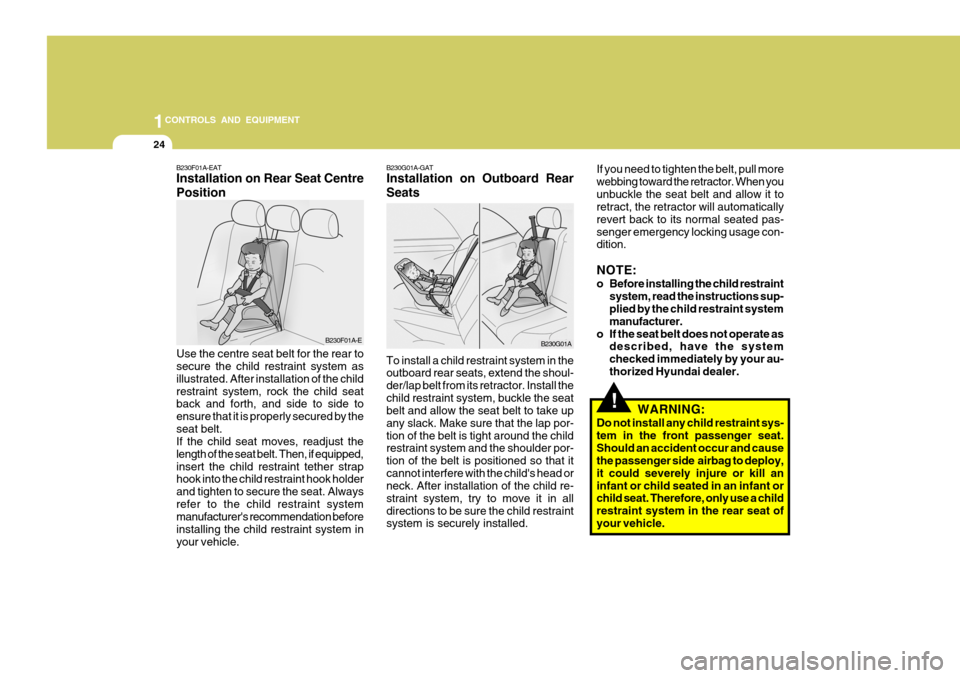
1CONTROLS AND EQUIPMENT
24
!
If you need to tighten the belt, pull more webbing toward the retractor. When youunbuckle the seat belt and allow it to retract, the retractor will automatically revert back to its normal seated pas-senger emergency locking usage con- dition. NOTE:
o Before installing the child restraint
system, read the instructions sup- plied by the child restraint system manufacturer.
o If the seat belt does not operate as described, have the systemchecked immediately by your au-thorized Hyundai dealer.
WARNING:
Do not install any child restraint sys-tem in the front passenger seat.Should an accident occur and cause the passenger side airbag to deploy, it could severely injure or kill aninfant or child seated in an infant or child seat. Therefore, only use a child restraint system in the rear seat ofyour vehicle.
To install a child restraint system in the outboard rear seats, extend the shoul- der/lap belt from its retractor. Install thechild restraint system, buckle the seat belt and allow the seat belt to take up any slack. Make sure that the lap por-tion of the belt is tight around the child restraint system and the shoulder por- tion of the belt is positioned so that itcannot interfere with the child's head or neck. After installation of the child re- straint system, try to move it in alldirections to be sure the child restraint system is securely installed.
B230G01A-GAT Installation on Outboard Rear Seats
B230G01A
B230F01A-EAT Installation on Rear Seat Centre Position Use the centre seat belt for the rear to secure the child restraint system as illustrated. After installation of the childrestraint system, rock the child seat back and forth, and side to side to ensure that it is properly secured by theseat belt. If the child seat moves, readjust the length of the seat belt. Then, if equipped,insert the child restraint tether strap hook into the child restraint hook holder and tighten to secure the seat. Alwaysrefer to the child restraint system manufacturer's recommendation before installing the child restraint system inyour vehicle.
B230F01A-E
Page 432 of 599
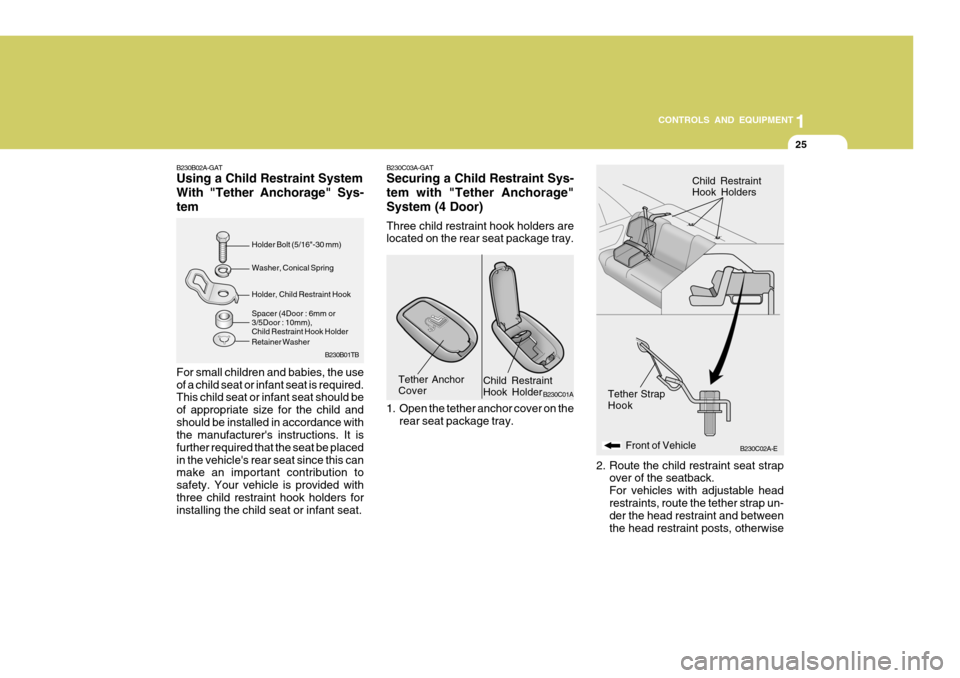
25
1
CONTROLS AND EQUIPMENT
B230B02A-GAT Using a Child Restraint System With "Tether Anchorage" Sys-tem For small children and babies, the use of a child seat or infant seat is required. This child seat or infant seat should be of appropriate size for the child andshould be installed in accordance with the manufacturer's instructions. It is further required that the seat be placedin the vehicle's rear seat since this can make an important contribution to safety. Your vehicle is provided withthree child restraint hook holders for installing the child seat or infant seat. Spacer (4Door : 6mm or 3/5Door : 10mm), Child Restraint Hook Holder
B230B01TB
Holder Bolt (5/16"-30 mm) Washer, Conical Spring Holder, Child Restraint Hook
Retainer Washer
B230C03A-GAT Securing a Child Restraint Sys- tem with "Tether Anchorage"System (4 Door) Three child restraint hook holders are located on the rear seat package tray.
B230C01A
1. Open the tether anchor cover on the rear seat package tray.
Tether Anchor Cover Child RestraintHook Holder
B230C02A-E
Front of Vehicle
Tether Strap Hook Child Restraint Hook Holders
2. Route the child restraint seat strap
over of the seatback. For vehicles with adjustable headrestraints, route the tether strap un- der the head restraint and between the head restraint posts, otherwise
Page 433 of 599
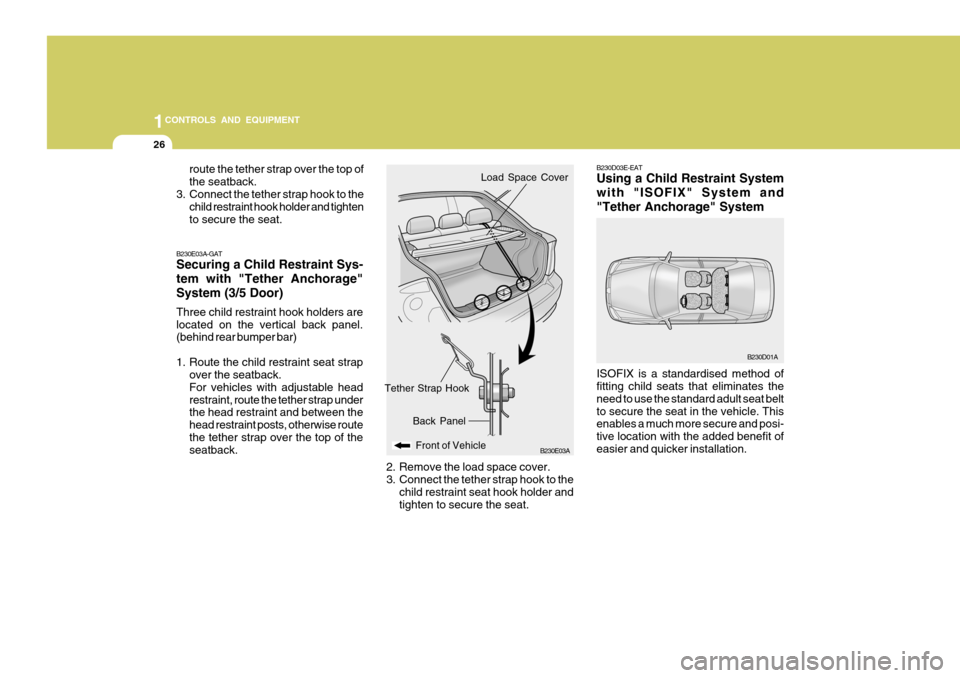
1CONTROLS AND EQUIPMENT
26
B230D03E-EAT Using a Child Restraint System with "ISOFIX" System and"Tether Anchorage" System
B230D01A
ISOFIX is a standardised method of fitting child seats that eliminates the need to use the standard adult seat beltto secure the seat in the vehicle. This enables a much more secure and posi- tive location with the added benefit ofeasier and quicker installation.
B230E03A
Front of Vehicle
Back Panel Load Space Cover
2. Remove the load space cover.
3. Connect the tether strap hook to the child restraint seat hook holder and tighten to secure the seat.
Tether Strap Hook
B230E03A-GAT Securing a Child Restraint Sys- tem with "Tether Anchorage" System (3/5 Door) Three child restraint hook holders are located on the vertical back panel. (behind rear bumper bar)
1. Route the child restraint seat strap over the seatback. For vehicles with adjustable headrestraint, route the tether strap under the head restraint and between the head restraint posts, otherwise routethe tether strap over the top of the seatback.
route the tether strap over the top of the seatback.
3. Connect the tether strap hook to the child restraint hook holder and tightento secure the seat.
Page 434 of 599
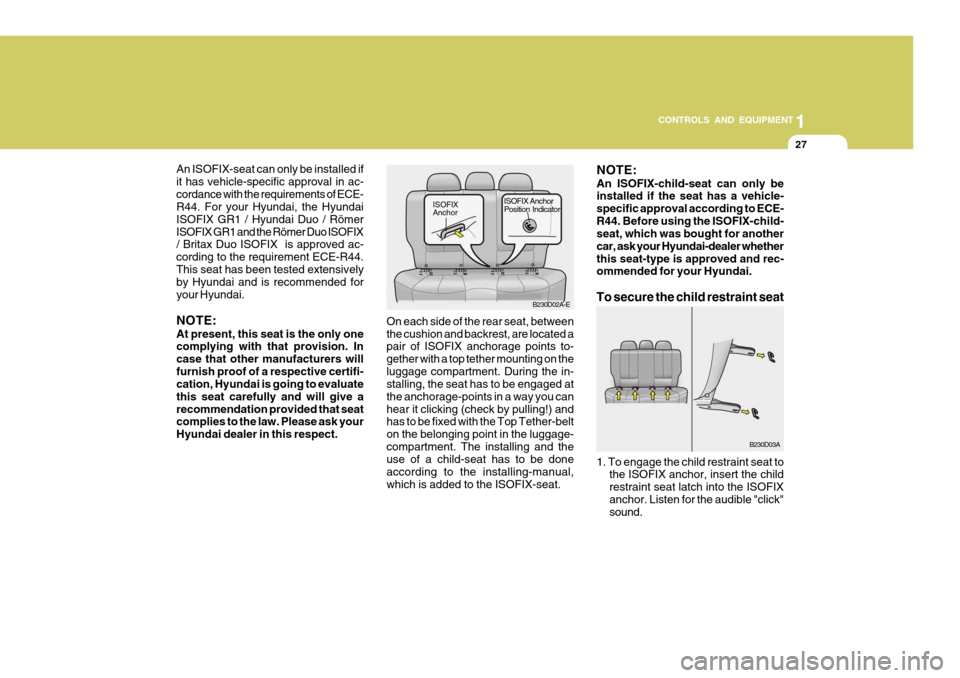
27
1
CONTROLS AND EQUIPMENT
An ISOFIX-seat can only be installed if it has vehicle-specific approval in ac-cordance with the requirements of ECE- R44. For your Hyundai, the Hyundai ISOFIX GR1 / Hyundai Duo / RömerISOFIX GR1 and the Römer Duo ISOFIX / Britax Duo ISOFIX is approved ac- cording to the requirement ECE-R44.This seat has been tested extensively by Hyundai and is recommended for your Hyundai. NOTE: At present, this seat is the only one complying with that provision. In case that other manufacturers willfurnish proof of a respective certifi- cation, Hyundai is going to evaluate this seat carefully and will give arecommendation provided that seat complies to the law. Please ask your Hyundai dealer in this respect.
On each side of the rear seat, between the cushion and backrest, are located a pair of ISOFIX anchorage points to- gether with a top tether mounting on theluggage compartment. During the in- stalling, the seat has to be engaged at the anchorage-points in a way you canhear it clicking (check by pulling!) and has to be fixed with the Top Tether-belt on the belonging point in the luggage-compartment. The installing and the use of a child-seat has to be done according to the installing-manual,which is added to the ISOFIX-seat. B230D02A-E
ISOFIX AnchorISOFIX Anchor Position Indicator
NOTE: An ISOFIX-child-seat can only be installed if the seat has a vehicle- specific approval according to ECE-R44. Before using the ISOFIX-child- seat, which was bought for another car, ask your Hyundai-dealer whetherthis seat-type is approved and rec- ommended for your Hyundai. To secure the child restraint seat
B230D03A
1. To engage the child restraint seat to the ISOFIX anchor, insert the child restraint seat latch into the ISOFIXanchor. Listen for the audible "click" sound.
Page 435 of 599
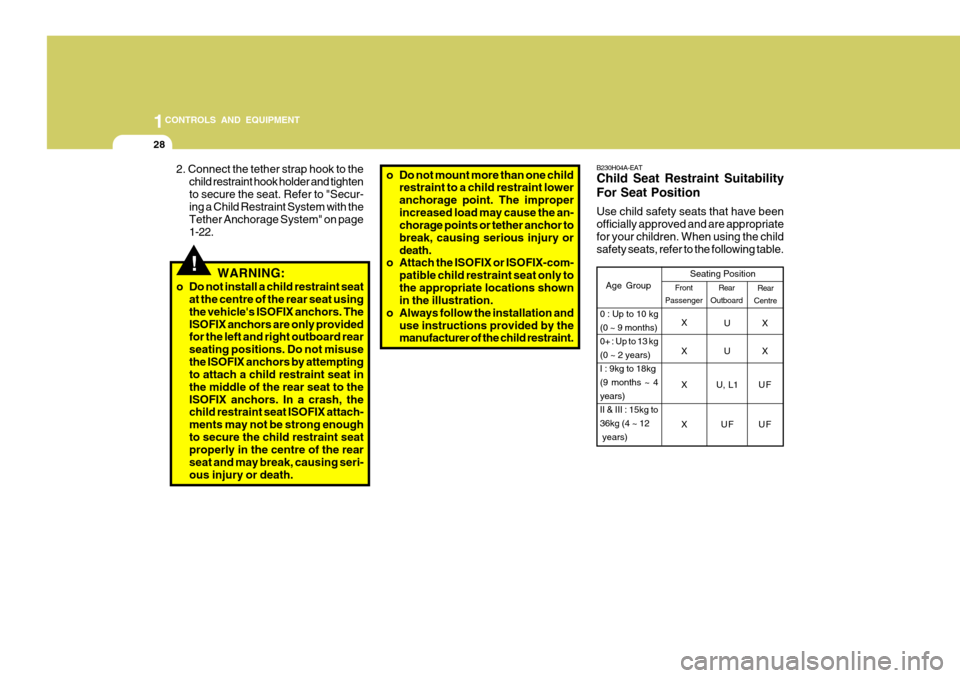
1CONTROLS AND EQUIPMENT
28
B230H04A-EAT Child Seat Restraint Suitability For Seat Position Use child safety seats that have been officially approved and are appropriatefor your children. When using the child safety seats, refer to the following table.
Rear
Centre
Age Group Seating Position
UX
XUX
X U, L1 U F XU FUF
Rear
Outboard
Front
Passenger
0 : Up to 10 kg (0 ~ 9 months)0+ : Up to 13 kg(0 ~ 2 years)I : 9kg to 18kg(9 months ~ 4years)II & III : 15kg to36kg (4 ~ 12 years) X
o Do not mount more than one child
restraint to a child restraint lower anchorage point. The improperincreased load may cause the an- chorage points or tether anchor to break, causing serious injury ordeath.
o Attach the ISOFIX or ISOFIX-com-
patible child restraint seat only tothe appropriate locations shown in the illustration.
o Always follow the installation and
use instructions provided by themanufacturer of the child restraint.
!
2. Connect the tether strap hook to thechild restraint hook holder and tighten to secure the seat. Refer to "Secur- ing a Child Restraint System with the Tether Anchorage System" on page1-22.
WARNING:
o Do not install a child restraint seat at the centre of the rear seat usingthe vehicle's ISOFIX anchors. TheISOFIX anchors are only provided for the left and right outboard rear seating positions. Do not misusethe ISOFIX anchors by attempting to attach a child restraint seat in the middle of the rear seat to theISOFIX anchors. In a crash, the child restraint seat ISOFIX attach- ments may not be strong enoughto secure the child restraint seat properly in the centre of the rear seat and may break, causing seri-ous injury or death.
Page 436 of 599
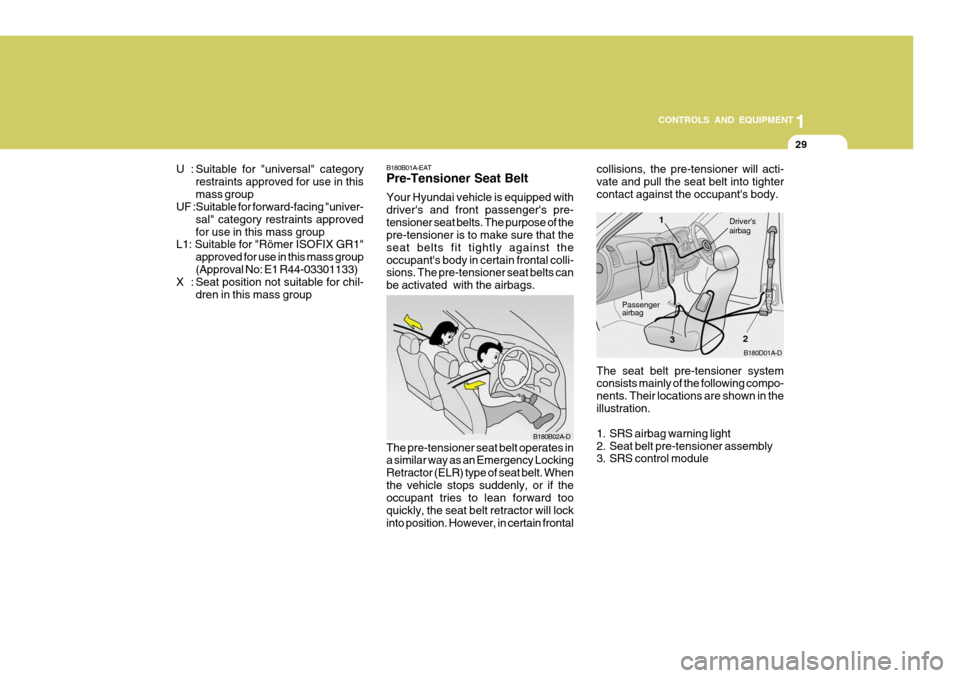
29
1
CONTROLS AND EQUIPMENT
U : Suitable for "universal" category
restraints approved for use in this mass group
UF :Suitable for forward-facing "univer-
sal" category restraints approvedfor use in this mass group
L1: Suitable for "Römer ISOFIX GR1"
approved for use in this mass group(Approval No: E1 R44-03301133)
X : Seat position not suitable for chil-
dren in this mass group
The seat belt pre-tensioner system consists mainly of the following compo- nents. Their locations are shown in theillustration.
1. SRS airbag warning light
2. Seat belt pre-tensioner assembly
3. SRS control module B180D01A-D
Driver's airbag1
2
3
Passenger airbag
The pre-tensioner seat belt operates in a similar way as an Emergency Locking Retractor (ELR) type of seat belt. Whenthe vehicle stops suddenly, or if the occupant tries to lean forward too quickly, the seat belt retractor will lockinto position. However, in certain frontal B180B02A-D
B180B01A-EAT Pre-Tensioner Seat Belt Your Hyundai vehicle is equipped with driver's and front passenger's pre-tensioner seat belts. The purpose of the pre-tensioner is to make sure that the seat belts fit tightly against theoccupant's body in certain frontal colli- sions. The pre-tensioner seat belts can be activated with the airbags.
collisions, the pre-tensioner will acti-vate and pull the seat belt into tightercontact against the occupant's body.
Page 437 of 599
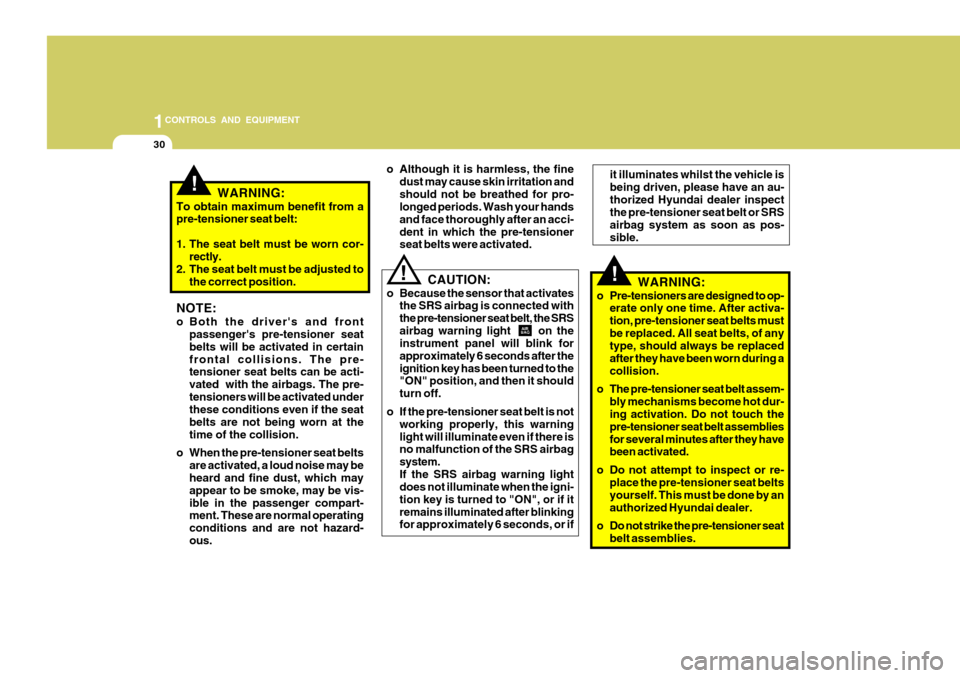
1CONTROLS AND EQUIPMENT
30
!
o Although it is harmless, the fine
dust may cause skin irritation and should not be breathed for pro- longed periods. Wash your hands and face thoroughly after an acci-dent in which the pre-tensioner seat belts were activated.
CAUTION:
o Because the sensor that activates the SRS airbag is connected with the pre-tensioner seat belt, the SRSairbag warning light on the instrument panel will blink for approximately 6 seconds after theignition key has been turned to the "ON" position, and then it should turn off.
o If the pre-tensioner seat belt is not working properly, this warninglight will illuminate even if there is no malfunction of the SRS airbag system.If the SRS airbag warning light does not illuminate when the igni- tion key is turned to "ON", or if itremains illuminated after blinking for approximately 6 seconds, or if
!
it illuminates whilst the vehicle is being driven, please have an au-thorized Hyundai dealer inspect the pre-tensioner seat belt or SRS airbag system as soon as pos-sible.
WARNING:
o Pre-tensioners are designed to op- erate only one time. After activa-tion, pre-tensioner seat belts mustbe replaced. All seat belts, of any type, should always be replaced after they have been worn during acollision.
o The pre-tensioner seat belt assem- bly mechanisms become hot dur- ing activation. Do not touch the pre-tensioner seat belt assembliesfor several minutes after they have been activated.
o Do not attempt to inspect or re- place the pre-tensioner seat belts yourself. This must be done by anauthorized Hyundai dealer.
o Do not strike the pre-tensioner seat belt assemblies.
!WARNING:
To obtain maximum benefit from a pre-tensioner seat belt:
1. The seat belt must be worn cor- rectly.
2. The seat belt must be adjusted to
the correct position.
NOTE:
o Both the driver's and front passenger's pre-tensioner seat belts will be activated in certain frontal collisions. The pre- tensioner seat belts can be acti- vated with the airbags. The pre-tensioners will be activated under these conditions even if the seat belts are not being worn at thetime of the collision.
o When the pre-tensioner seat belts are activated, a loud noise may be heard and fine dust, which may appear to be smoke, may be vis-ible in the passenger compart- ment. These are normal operating conditions and are not hazard-ous.
Page 438 of 599
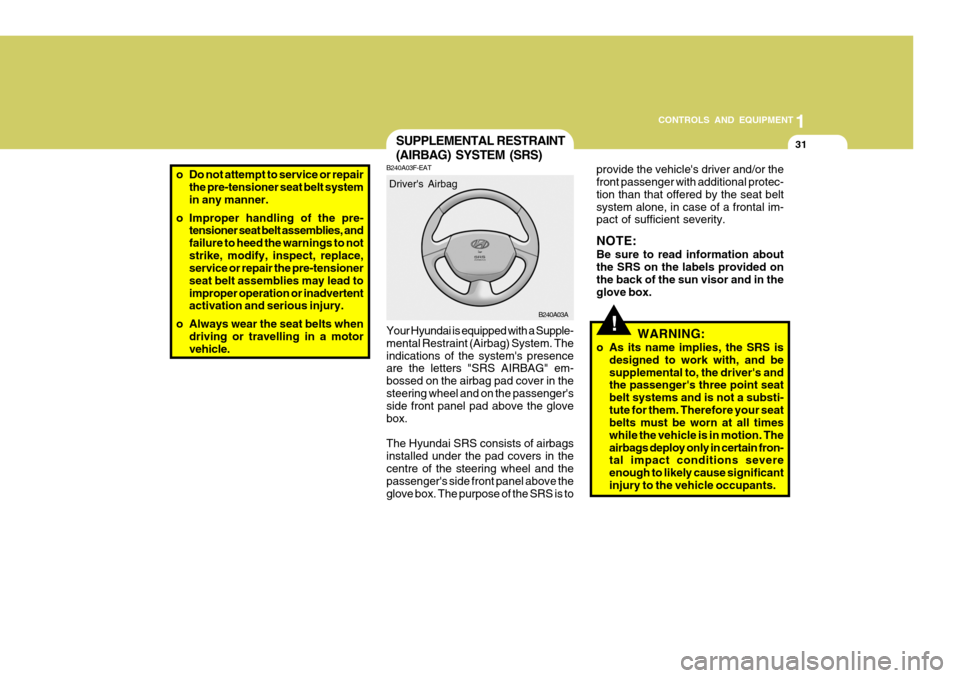
31
1
CONTROLS AND EQUIPMENT
o Do not attempt to service or repair
the pre-tensioner seat belt system in any manner.
o Improper handling of the pre- tensioner seat belt assemblies, and failure to heed the warnings to notstrike, modify, inspect, replace, service or repair the pre-tensioner seat belt assemblies may lead toimproper operation or inadvertent activation and serious injury.
o Always wear the seat belts when driving or travelling in a motor vehicle.
SUPPLEMENTAL RESTRAINT (AIRBAG) SYSTEM (SRS)
!WARNING:
o As its name implies, the SRS is designed to work with, and be supplemental to, the driver's and the passenger's three point seat belt systems and is not a substi-tute for them. Therefore your seat belts must be worn at all times while the vehicle is in motion. Theairbags deploy only in certain fron- tal impact conditions severe enough to likely cause significantinjury to the vehicle occupants.
provide the vehicle's driver and/or the front passenger with additional protec- tion than that offered by the seat beltsystem alone, in case of a frontal im- pact of sufficient severity. NOTE: Be sure to read information about the SRS on the labels provided onthe back of the sun visor and in the glove box.
Your Hyundai is equipped with a Supple- mental Restraint (Airbag) System. Theindications of the system's presence are the letters "SRS AIRBAG" em- bossed on the airbag pad cover in thesteering wheel and on the passenger's side front panel pad above the glove box. The Hyundai SRS consists of airbags installed under the pad covers in thecentre of the steering wheel and the passenger's side front panel above the glove box. The purpose of the SRS is to
B240A03F-EAT
B240A03A
Driver's Airbag
Page 439 of 599
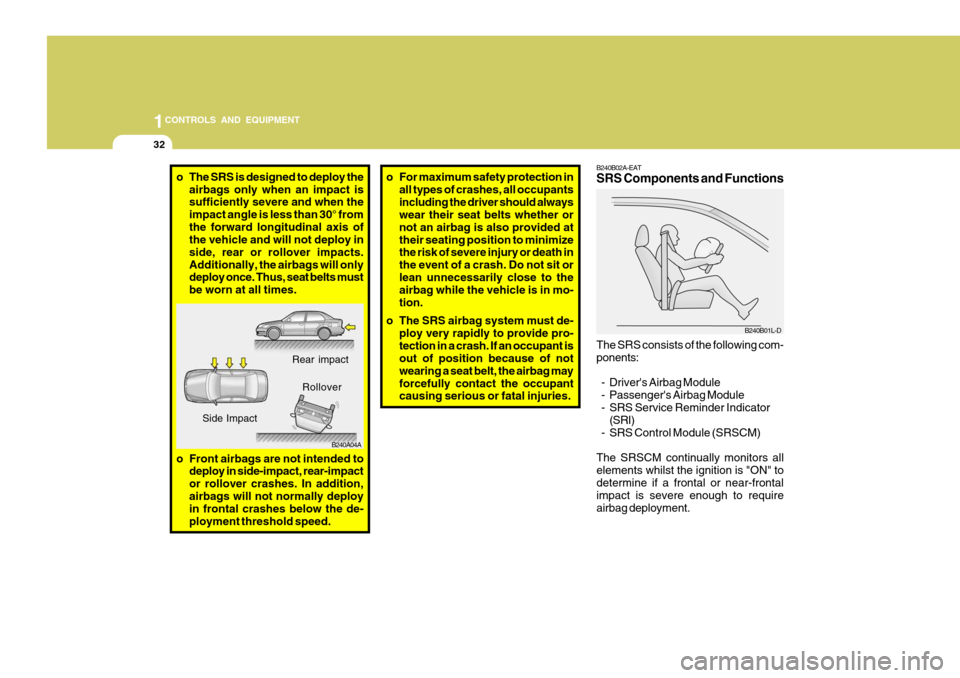
1CONTROLS AND EQUIPMENT
32
o For maximum safety protection in
all types of crashes, all occupants including the driver should always wear their seat belts whether or not an airbag is also provided attheir seating position to minimize the risk of severe injury or death in the event of a crash. Do not sit orlean unnecessarily close to the airbag while the vehicle is in mo- tion.
o The SRS airbag system must de- ploy very rapidly to provide pro-tection in a crash. If an occupant is out of position because of not wearing a seat belt, the airbag mayforcefully contact the occupant causing serious or fatal injuries. The SRS consists of the following com- ponents:
- Driver's Airbag Module
- Passenger's Airbag Module
- SRS Service Reminder Indicator (SRI)
- SRS Control Module (SRSCM)
The SRSCM continually monitors allelements whilst the ignition is "ON" todetermine if a frontal or near-frontal impact is severe enough to require airbag deployment.
B240B02A-EAT SRS Components and Functions
B240B01L-D
B240A04A
Rear impact
Side Impact Rollover
o The SRS is designed to deploy the
airbags only when an impact is sufficiently severe and when the impact angle is less than 30° fromthe forward longitudinal axis of the vehicle and will not deploy in side, rear or rollover impacts.Additionally, the airbags will only deploy once. Thus, seat belts must be worn at all times.
o Front airbags are not intended to deploy in side-impact, rear-impactor rollover crashes. In addition,airbags will not normally deploy in frontal crashes below the de- ployment threshold speed.
Page 440 of 599
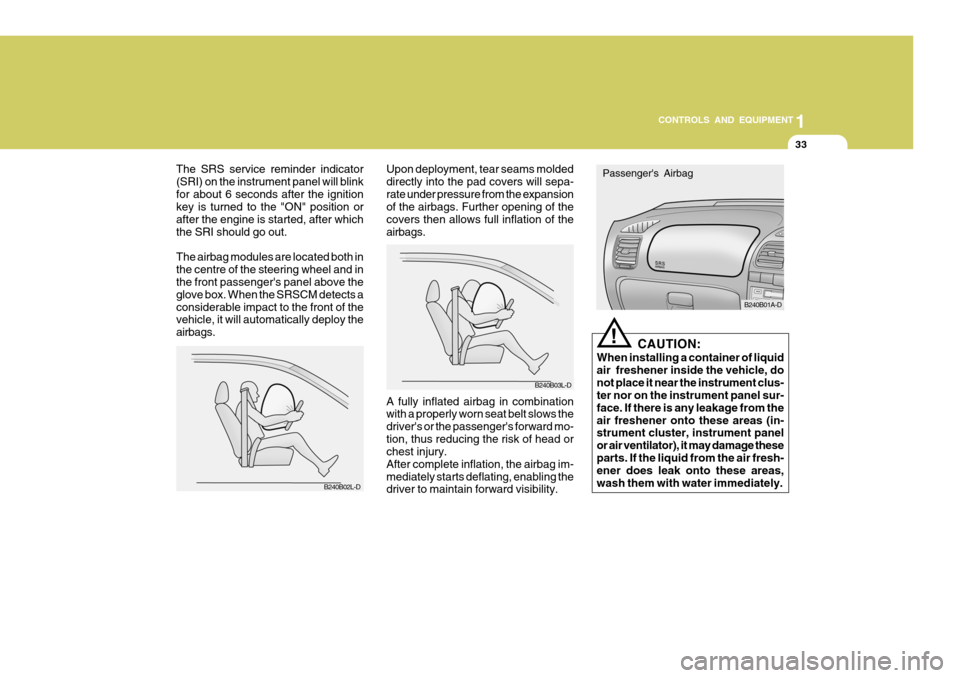
33
1
CONTROLS AND EQUIPMENT
The SRS service reminder indicator (SRI) on the instrument panel will blinkfor about 6 seconds after the ignition key is turned to the "ON" position or after the engine is started, after whichthe SRI should go out. The airbag modules are located both in the centre of the steering wheel and in the front passenger's panel above the glove box. When the SRSCM detects aconsiderable impact to the front of the vehicle, it will automatically deploy the airbags.
B240B02L-D
B240B03L-D
Upon deployment, tear seams molded directly into the pad covers will sepa-rate under pressure from the expansion of the airbags. Further opening of the covers then allows full inflation of theairbags. A fully inflated airbag in combination with a properly worn seat belt slows the driver's or the passenger's forward mo-tion, thus reducing the risk of head or chest injury. After complete inflation, the airbag im-mediately starts deflating, enabling the driver to maintain forward visibility.
CAUTION:
When installing a container of liquid air freshener inside the vehicle, donot place it near the instrument clus- ter nor on the instrument panel sur- face. If there is any leakage from theair freshener onto these areas (in- strument cluster, instrument panel or air ventilator), it may damage theseparts. If the liquid from the air fresh- ener does leak onto these areas, wash them with water immediately.
! B240B01A-D
Passenger's Airbag